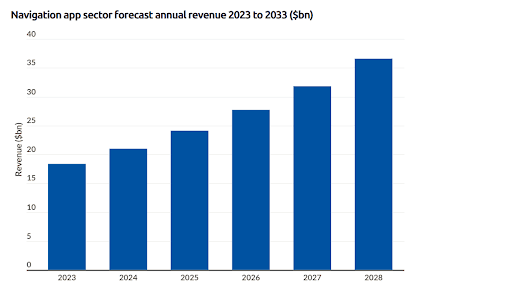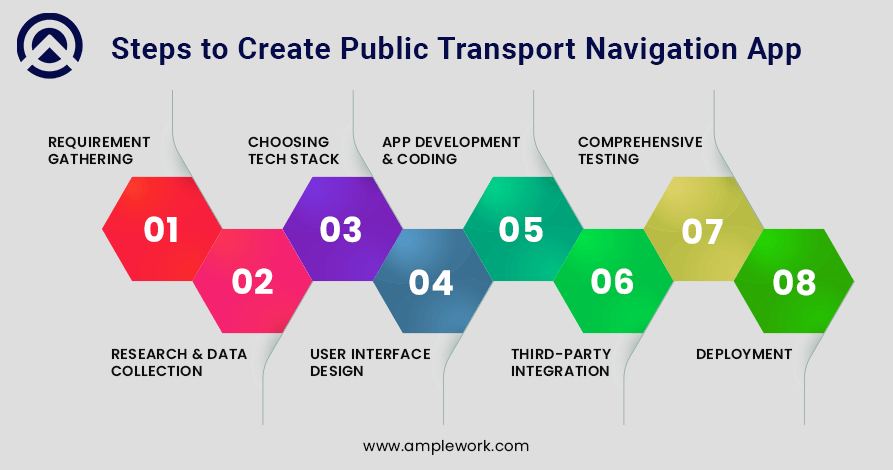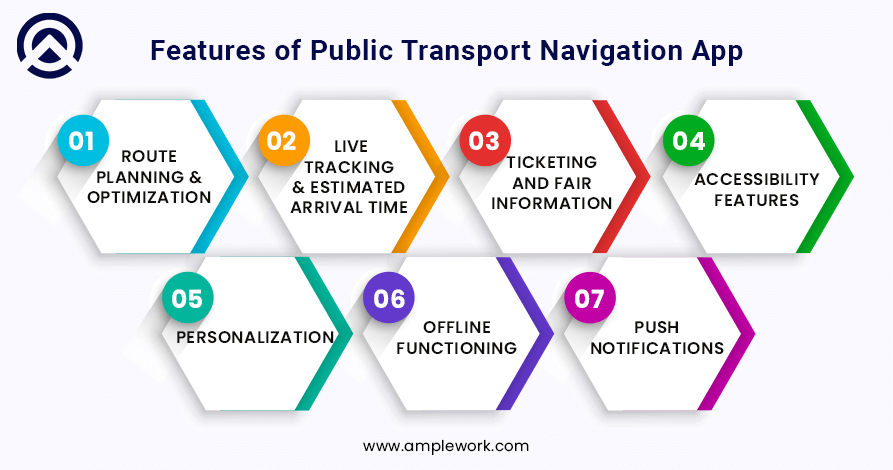A Complete Guide for Public Transport Navigation App Development
Public transport, which is considered the bloodline of urban mobility, faces challenges like crowded commutes, complex networks, and real-time disruptions. From buses and trains to trams and subways, millions of travelers rely on these networks daily to navigate their way through their desired destinations. However, as we have witnessed that the cities are growing and evolving, the need for smart, user-friendly navigation tools becomes increasingly apparent.
This need to create a mobile application for public transport navigation has become a trend in the current scenario. Since you are here it is obvious that you need to create an efficient public transport navigation mobile app for your business. For the same being aware of the overall development process is a must. However, with the growing cities with their complex roadmap structure, the challenges of navigating their public transport networks. This is where the power of technology comes into consideration, offering developers the opportunity to create innovative solutions that streamline the commuting experience for millions of people living in that particular area.
Creating a robust app to help the movers effortlessly plan their travel, making them access real-time information, and allowing them to navigate through the complex web of transit options available in their preferred areas of the city. These apps serve as digital compasses, guiding users through the range of available bus routes, subway lines, and train schedules with ease. These transportation management systems can be created by incorporating the power of data integration, user-centric design, and real-time updates. Transportation app developers can create robust applications that revolutionize the way people move within cities. But that can be only possible when they follow an efficient process.
Blog’s Motive
In this blog, we will be discussing the path to creating a comprehensive public transport navigation app from designing an intuitive interface for them to navigating through the complex data integration process. The developers have to face a vast variety of challenges to deliver their users with a seamless user experience. This roadmap to create a public transport navigation app can be a game changer for them.
Addressing Some Specific Research Outcomes
According to data generated by the experts of a well-known organization that is “Business of Apps” which states that the navigation app sector has generated a huge revenue of approximately $16.2 billion in the year 2022. And the countdown for the same is still moving in the upward direction. This research data also considers that this revenue will reach the height of approximately $36.6 Billion by the year 2028. Also one of the researchers Morgan Stanley estimated that Google Maps will be earning a revenue of $11.1 billion within the current year that is 2024 through the introduction of their new travel products and promoted pins, for generating increased revenue for the same.

Here’s a Developer’s Roadmap to Create a Comprehensive Public Transport Navigation App
Crafting a public transport navigation app for iPhone and Android can be a challenging process that comprises a series of defined steps, that initially start from requirement analysis to strategizing, designing, development, testing, and deployment. Here’s a complete roadmap for developers to facilitate best-in-class public transport navigation mobile app development.

1. Requirement Gathering:
The initial phase of developing a mobile application for transport navigation is to gather the actual requirements of both the business and its targeted audiences. To understand the actual functionalities that are needed by them. Also, you need to effectively define your scope to transport management software developers that ensure the geographical boundaries whether the app covers a single city, region, or nation-wide. To specify all the requirements you should research the existing public transport systems and also identify the accessibility needs.
2. Research & Data Collection:
For securing access to real-time and historical data based on the fares, disruptions, service changes, and accessibility information for effectively processing the public transport navigation mobile application development. This research data helps your business to effectively understand all your competitors and the actual requirements of your targeted travelers. Allowing you to deliver them with a robust, futuristic, and efficient mobile app for public transport navigation.
3. Choosing Tech Stack:
After you are finished with the market research and planning, the next phase is to facilitate the selection of relevant technologies for crafting such applications. Also, you need to decide whether the application will be launched for a single or multiple platforms. Choosing a relevant and advanced tech stack leads the mobile app development services to craft an advanced and custom mobile app that meets all the requirements of users.
4. User Interface Design:
Creating an intuitive and visually appealing interface that makes it easy for users to navigate the mobile application and find their desired public transport on their preferred route with ease. For the same, you should consider incorporating features such as an interactive map, a customizable platform according to user’s preferences multi-modal trip planning, and many others to offer your users a seamless user experience.
5. App Development & Coding:
The development phase consists of multiple aspects, particularly the frontend and backend. For creating an efficient transportation management system there’s a need to facilitate the coding for crafting both ends. For Frontend you can specifically choose platforms like React native, jQuery, Vue, or Flutter. Whereas for the Backend you need to build the backend infrastructure to support data processing, routing algorithms, and real-time updates. Also, you need to focus on its scalability and reliability.
6. Third-party Integration:
Integrating the third-party components to the app to ensure its efficient and speedy functioning. You can integrate features such as traffic information, Public transport routing systems, and weather updation systems into your app which can help the user to plan their desired public transport on their nearby routes effectively. Considering the weather conditions and routes.
7. Comprehensive Testing:
You should conduct thorough testing on various devices and network conditions. Ensure accessibility compliance and gather user feedback through beta testing. Comprehensive rigorous testing mechanisms always help you identify the errors and bugs that are present in your public transport navigation mobile app. Ensuring accessibility compliance and beta testing standards can offer your users a seamless app usage experience.
8. Deployment:
Choose the appropriate platform for which the transport management software has been created and follow all the implementation guidelines according to that particular platform for its successful deployment without any hassles. After this, you need to leverage social media and marketing techniques to get a better user reach for your app by creating awareness amongst the users.
Read more: 10 Useful Tips From Experts For Mobile App Development Services
Necessary Features and Functionalities of Public Transport Navigation App
Every Public transit navigation app should have some of the necessary features and functionalities that decide its popularity amongst the targeted user base. A transit mobile app offers ease of access to all the users. Here are some of the most essential features that a public transport navigation app must have:

1. Route Planning & Optimization:
By implementing these core GPS tracking features you should allow users to input their origin and destination, offering multiple route options with travel times, transfers, walking distances, and accessibility information. Also, it should consider real-time disruptions and suggest alternative routes, public transport, or the shortest path to reach the destination to individuals.
2. Live Tracking & Estimated Arrival Time:
To avoid longer waits at public transport stops you should integrate this feature for showcasing the real-time location of buses, trains, trams, etc. It should also offer them estimated arrival times and next-stop notifications so that they can easily choose the speediest means of transport to make them reach their destination rapidly and leads to informed waiting times, enhancing the user experience and avoiding the longer waits for public transportation due to some circumstances.
3. Ticketing and Fair Information:
Integrating the ticketing systems for seamless in-app purchases for the tickets if it is available. Also through this feature, you can display the fare options, e-ticketing dashboard, and payment options with multilingual support for facilitating the users. Fare information with route plans also helps the users choose the shortest path and the cheapest means of transport for their daily commutes.
4. Accessibility Features:
Prioritize the accessibility from the start, using clear fonts, high contrast, text-to-speech options, and screen reader compatibility. You should also integrate features like elevator availability at stations, route accessibility for finding the best possible path for their destination, and additional facility information about their routes.
5. Personalization:
The personalization feature allows the users to save their favorite routes, set home and work locations, and receive personalized alerts for disruptions or changes affecting their usual journeys, enhancing their overall usage experience, that too by offering them convenient public transport navigation. User personalization also helps the brands offer the users complete app usage satisfaction, resulting in gaining a larger user base through increased recommendations.
6. Offline Functioning:
We all are aware that sometimes in some areas the speed of the internet is much slower and also due to some unforeseen circumstances the network is not available. To cope with this problem you should ensure features like route planning and saved public transport schedules are accessible even without internet connectivity. Allows the users to access their preferred public transport without any hassles, even during limited or no internet connectivity.
7. Push Notifications:
The push notification feature is used to inform the users about different updates. For instance, if there is simply a traffic jam on the route of their preferred public transport then it will simply update you about the same. It can also make you aware of ongoing traffic jams, emergencies, or any sort of unexpected interruptions such as road construction, or delays due to road accidents. Providing the users with a sort of real-time updates for effectively planning their journeys.
Conclusion
Building a great public transport navigation app isn’t just about functionality, instead, it is all about impact on your targeted audiences. Crafting a robust Transport navigation app for Android and iOS as well, can empower users by simplifying their daily commutes, and create the way for greener, more efficient cities. From reduced traffic congestion to stronger communities, the potential ripples outward. So, keep innovating, embrace feedback, and chart a course for progress. Let your app be the guide that leads us to a future. Where public transport has been simplified for every individual, making it their preferred choice for enhancing environmental sustainability. In this blog, we have discussed a series of steps with a set of necessary features and functionalities. To create a desired roadmap for the public transport navigation mobile application development.
At Amplework, your trusted transportation application development company. Our team of experts go out of the box, to craft transformative contactless payment solutions. That empowers your clients and unlocks hidden efficiencies. Our team of passionate experts isn’t just skilled in mobile app development but are also collaborative innovators. As they utilize the latest tech stack to tailor solutions specifically according to your needs. Integrating seamless payments, intuitive user experiences, and data security which you can trust. Partnering with Amplework isn’t just about getting a new app, it’s about unlocking a new era for your business. So if you are still thinking above all, just share your idea with our team of seasoned development professionals to get an innovative solution.
Also Read: How Much Does it Cost To Develop a Mobile Application in 2024?



 sales@amplework.com
sales@amplework.com
 (+91) 9636-962-228
(+91) 9636-962-228





